 W
WMoorish architecture, is a style within Islamic architecture which developed in the western Islamic world, which included al-Andalus, and the Maghreb. The term "Moorish" comes from the Western European designation of the Muslim inhabitants of these regions as "Moors", which itself comes from Latin "Mauri", originally a designation of the inhabitants of the Berber kingdom of Mauretania. Some scholars also use the term Western Islamic architecture or "architecture of the Islamic west" for this subject.
 W
WAblaq is an architectural technique involving alternating or fluctuating rows of light and dark stone. Records trace the beginnings of this type of masonry technique to the southern parts of Syria. It is associated as an Arabic term, especially as related to Arabic Islamic architectural decoration. The first recorded use of the term ablaq pertained to repairs of the Great Mosque of Damascus in 1109, but the technique itself was used much earlier.
 W
WThe Agdal Gardens are a large area of historic gardens and orchards in Marrakesh, Morocco. The gardens are located to the south of the city's historic Kasbah and its royal palace. Together with the medina of Marrakech and the Menara Gardens, the Agdal Gardens were listed by UNESCO as a World Heritage Site in 1985. The gardens contain several historic water reservoirs as well as several historic palaces and pavilions, including the Dar el-Hana and the Dar al-Bayda.
 W
WAhl Fas Mosque is a mosque in the capital city of Rabat, Morocco. It is located at the mechouar of Al-Sayeed. The mosque was commissioned by the Alaouite sultan Mohammed ben Abdallah in the 18th century. It was renovated several times, during the era of Muhammad IV, Yusef, Muhammad V, Hassan II, and Muhammad VI. The mosque is known as a place where the king gives the khotbah (sermon) during the Friday Prayer or Eid Prayers, a tradition dating back to the era of Moulay Yusef.
 W
WBey's Palace or Ahmad Bey Palace is a historic palace in Constantine, Algeria. The palace was one of the main sights during the selection of Constantine as Arab Capital of Culture in 2015.
 W
WThe arabesque is a form of artistic decoration consisting of "surface decorations based on rhythmic linear patterns of scrolling and interlacing foliage, tendrils" or plain lines, often combined with other elements. Another definition is "Foliate ornament, used in the Islamic world, typically using leaves, derived from stylised half-palmettes, which were combined with spiralling stems". It usually consists of a single design which can be 'tiled' or seamlessly repeated as many times as desired. Within the very wide range of Eurasian decorative art that includes motifs matching this basic definition, the term "arabesque" is used consistently as a technical term by art historians to describe only elements of the decoration found in two phases: Islamic art from about the 9th century onwards, and European decorative art from the Renaissance onwards. Interlace and scroll decoration are terms used for most other types of similar patterns.
 W
WThe Bab Abi al-Jounoud or Bab Bou Jeloud is an ornate city gate in Fes el Bali, the old city of Fez, Morocco. The current gate dates was built by the French colonial administration in 1913 to serve as the grand entrance to the old city.
 W
WThe Bardo National Museum of Prehistory and Ethnography is a national museum located in Algiers, Algeria.
 W
WThe Bardo National Museum is a museum of Tunis, Tunisia, located in the suburbs of Le Bardo.
 W
WBeni Hammad Fort, also called Al Qal'a of Beni Hammad is a fortified palatine city in Algeria. Now in ruins, in the 11th century, it served as the first capital of the Hammadid dynasty. It is in the Hodna Mountains northeast of M'Sila, at an elevation of 1,418 metres (4,652 ft), and receives abundant water from the surrounding mountains. Beni Hammad Fort is near the town of Maadid, about 225 kilometres (140 mi) southeast of Algiers, in the Maghreb.
 W
WBorj Lalla Qadiya is a fort in the city of Rabat, Morocco. It is believed to be first built in the 17th century next to the tomb of a saint woman called Lalla Qdiya. It forms an important part of the walls protecting the city from northeast.
 W
WBorj Sidi Makhlouf is a fort in the city of Rabat, Morocco. It was first established in the 17th century and was destroyed in 1637 but conserved its shape. It is located in the cliff of the Bouregreg river and marked the transition from Andalusian to military architecture.
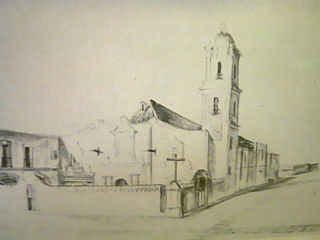 W
WThe Convent of Nuestra Señora de La Merced was a Roman Catholic colonial religious complex in present-day Historic center of Mexico City, that was destroyed to give more space to future buildings. The cloister is all that is left of a monastery complex built in the late 16th and early 17th century by the Mercedarian order. It is located on Uruguay and Talavera Streets in the historic downtown of Mexico City. The complex lent its name to the area around it, La Merced, which in turn, inspired the name of the metro station and the well-known neighborhood Market.
 W
WDar el Bacha is a palace located in the old medina of Marrakesh, Morocco.
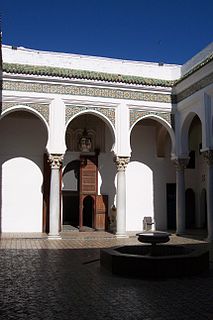 W
WThe Dar al-Makhzen or Sultanate Palace is a historical building and museum in Tangier, Morocco. It was the seat of residence for the Sultans of Morocco when staying in the city.
 W
WDar Mustapha Pacha is a Moorish palace, located in the Casbah of Algiers, Algiers, Algeria. It houses the National Museum of Miniatures, Illumination and Calligraphy.
 W
WDar-al-Makhzen is the primary and official residence of the king of Morocco. It is situated in the Touarga commune of Rabat, the national capital. Its official name is El Mechouar Essaid Palace, which means 'The Venue of Happiness Palace'.
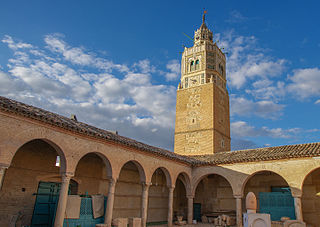 W
WThe Great Mosque of Testour is a mosque located in the city of Testour in Beja Governorate, Tunisia. It is 76 km from the capital Tunis, in the center of the old city. It embodies the Andalusian architecture, especially its minaret, which features Andalusian style inscriptions and architectural elements. The height of the minaret is 23 meters and it is an octagonal shape. The facade of the minaret are opened with small double windows decorated with glazed inscriptions and a mechanical clock at the top. Its appearance is resembling the Aragonese bell towers in southern Spain. The prayer hall, in addition to the sahn located in the center of the mosque, can accommodate up to 1000 worshipers. The construction of the mosque used limestone, Spanish sand and marble in addition to colored porcelain and tiles used in the construction of the mihrab. The mosque dates back to 1631, and its patron is Muhammad Tigharinu an immigrant of Andalusian origin who settled at Testour in 1609.
 W
WThe Ibn Danan Synagogue is a synagogue in Fes, Morocco, dating from the 17th century. It was built by Mimoun Ben Sidan, a wealthy merchant from the town of Ait Ishaq. The synagogue is located in the Mellah district within Fes el-Jdid, one of the components of the historic medina of Fes.
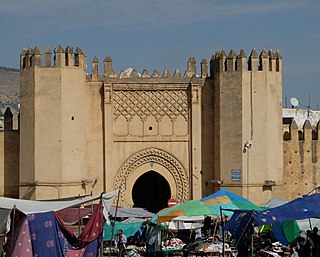 W
WThe Kasbah An-Nouar or Kasbah Filali is a walled district and former military enclosure in the old medina of Fez, Morocco. Its name means "citadel of the flowers", but it is sometimes also referred to as Kasbah Filala and Kasbah Chorfa. It is one of several fortified military enclosures or kasbahs that were built around the old city of Fez across different periods.
 W
WKasbah Gnawa, also referred to as: Kasbah of Gnaouas or Ismailian Kasbah is a kasbah located in the city of Salé in Morocco, and is the only one on the right bank of the Bou Regreg river.
 W
WThe lambrequin arch, also known as the muqarnas arch, is a type of arch with an ornate profile of lobes and points. It is especially characteristic of Moorish and Moroccan architecture.
 W
WThe Medina of Salé, or Salé old town is the medina quarter and the oldest walled part in the city of Salé in Morocco. It is classified as a national cultural heritage since October 1914, and is considered as one of the oldest medinas of Morocco.
 W
WThe Museum of Modern Art of Algiers (MaMa) is an art museum in Algiers. It was inaugurated in 2007.
 W
WMoroccan style is a new trend in decoration which takes its roots from Moorish architecture and Moroccan architecture, it has been made popular by the vogue of riads renovation in Marrakech. Its becoming popular in some circles in UK and the USA.
 W
WThe Mosque of the Andalusians or Al-Andalusiyyin Mosque, sometimes also called the Andalusian Mosque, is a major historic mosque in Fes el Bali, the old medina quarter of Fez, Morocco. The mosque was founded in 859-860, making it one of the oldest mosques in Morocco. It is located at the heart of a district which was historically associated with Andalusi immigrants, from which it takes its name. It has been renovated and expanded several times since then. Today, it is one of the relatively few remaining Idrisid-era establishments and one of the main landmarks of the city.
 W
WThe Great Mosque of Kairouan, also known as the Mosque of Uqba, is a mosque situated in the UNESCO World Heritage town of Kairouan, Tunisia and is one of the most impressive and largest Islamic monuments in North Africa.
 W
WA multifoil arch, sometimes also called a polylobed arch, is an architectural element of an arch containing multiple foils; symmetrical leaf shapes, defined by overlapping circles. The term foil comes from the old French word for "leaf." A specific number of foils is indicated by a prefix: trefoil (three), quatrefoil (four), cinquefoil (five), sexfoil (six), octofoil (eight), or multifoil and polyfoil for typically more than eight.
 W
WPalace of the Dey, also known as Algeria Castle or Dey Hussein Palace, is an Ottoman era palace in the city of Algiers, Algeria. Completed in the 16th century, it is situated inside the Casbah of Algiers, and settled by successive deys of the city. It once was the second largest palace in the Ottoman Empire, next to Topkapi Palace in Istanbul.
 W
WThe Palais des Rais, also known as Bastion 23, is a classified historical monument located in Algiers, Algeria. It is notable for its architecture and for being the last surviving quarter (houma) of the lower Casbah.
 W
WA riad is a type of traditional Moroccan and Andalusi interior garden or courtyard associated with house and palace architecture. Its origin is generally attributed to Persian gardens that spread during the Islamic period. The term is nowadays often used in Morocco to refer to a hotel or guesthouse-style accommodation with shared common areas and private rooms, often within a restored traditional mansion.
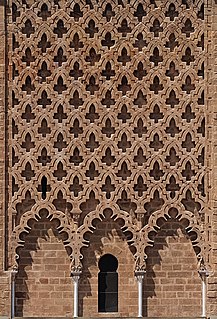 W
WSebka refers to a type of decorative motif used in historic western Islamic ("Moorish") architecture, Mudéjar architecture, and up to present-day Moroccan architecture.
 W
WSocarrat refers to fired clay tiles covered with a white base and generally painted in red and black. These were placed between beams and joists in buildings’ ceilings and eaves. Their origin is typically medieval but subsequent production of these objects is known, mainly in Valencia. There are other words to name objects with similar function such as rajola, maó prim, atovó or cairó. The first register about its existence takes us back to 1604, when D. Feliciano de Figueroa, Bishop of Segorbe, refers to a group of roof and wall tiles written and coloured with koranic transcripts. Traditionally, they’re said to come from Paterna but the presence of these and other similar objects has been documented too in Manises and in some other places in Valencia, Aragon and Catalonia.
 W
WTadelakt is a waterproof plaster surface used in Moroccan architecture to make baths, sinks, water vessels, interior and exterior walls, ceilings, roofs, and floors. It is made from lime plaster, which is rammed, polished, and treated with soap to make it waterproof and water-repellant. Tadelakt is labour-intensive to install, but durable. Since it is applied as a paste, tadelakt has a soft, undulating character, it can form curves, and it is seamless. Pigment can be added to give it any colour, but deep red is traditional. It may have a shiny or matte finish.
 W
WThe Villa Abd-el-Tif, also known as la Villa Medicis algérienne, is a Moorish villa located in Algiers, Algeria. It is notable for having been set up in 1907 in emulation of the French Academy in Rome, the Villa Medici. It was, until 1962, home to the laureates of the Abd-el-Tif prize who were offered bursaries to continue their studies for two years in Algeria. Abandoned after the independence of the country, it was classified as a historical monument in 1967 and restored before reopening in 2008. It now houses the headquarters of the Agence algérienne pour le rayonnement culturel (AARC).
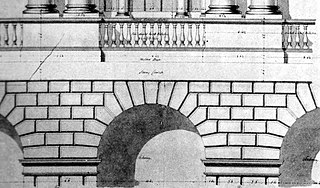 W
WA voussoir is a wedge-shaped element, typically a stone, which is used in building an arch or vault.
 W
WThe Zawiya of Sidi Ahmed al-Tijani, or Zawiya Tijaniya Al Koubra, is a zawiya, an Islamic religious complex building for education and commemoration, in Fez, Morocco. The building is located inside Fes el Bali, the old medina quarter of the city. More specifically, it is situated in the Al-Blida neighborhood, close to the University of Al Quaraouiyine. It is dedicated to the founder of the Tijaniyyah tariqa from the 18th century, Sheikh Ahmad al-Tijani who is buried in the site. It is among the several other zawiyas dedicated to Al-Tijani. The complex is distinguishable from highly ornamented facades facing the street, and a minaret in turquoise color.